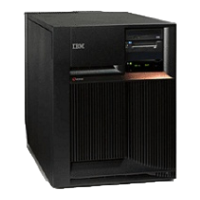v No: Continue with the next step.
v Yes: You can not use this procedure to power off the tower. Doing so will cause a system failure.
You must power down the system to continue working on this tower. See Power on/off the system
and logical partitions.
This
ends the procedure.
12.
Are you working in a FC 5079 expansion tower or unit?
v No: Continue with the next step.
v Yes: Power off only the expansion tower or unit (FC 5074) that you are servicing and continue
with the next step.
Attention: Only one expansion tower inside the 1.8 meter rack may be powered off at any given
time.
13.
Were you directed to power off the tower to set the SPCN configuration ID?
v No: Continue with the next step.
v Yes: Go to step 16 (See page 567).
14. Verify that the ″type numbers″ (that is, IOPs, IOAs, and so on) contained in the expansion tower or
unit that you are powering off matches what is shown on the system by performing the following:
a. From the SST or DST menu, select Start a service tool —> Hardware service manager —>
Packaging Hardware Resources (systems, frames, cards, and so on.).
b. Select Hardware contained within package for the Frame ID of the Expansion Unit. Ensure
that all of the resources displayed match the resources in the expansion tower or unit that you are
powering off.
Note: If you have only the resource name, select Locate Resource by Resource Name and
display the Associated packaging resource(s) for the selected resource. Use the Frame ID shown.
15.
Work with the customer to end all bus activity in the tower by performing one of the following:
Note: If multiple logical partitions own IOPs on the bus, then the customer will be directed to end all
of the bus activity in each of those partitions.
v If the expansion tower or unit does not contain disk unit IOPs, work with the customer to end all
jobs and vary off all devices, lines, and controllers for that expansion tower or unit.
v If the expansion tower or unit contains disk unit IOPs and the disk units are not mirrored to disk
units in other expansion towers or units, work with the customer to end all communications
activities to these disk units by ending all subsystems.
v If the expansion tower or unit contains disk unit IOPs and these disk units are mirrored to disk
units in other expansion towers or units, you do not need to end all subsystems. Mirroring will
assist during the service action.
v If the system has a non-redundant (single hub configuration) OptiConnect bus, work with the
customer to end all jobs and vary off the QSOC resources on the affected system.
Note: Use the WRKOPCACT command to work with the QSOC resources on the affected system.
v If the system has a redundant (dual hub configuration) OptiConnect bus, you do not need to end
subsystems or vary off the resources. Redundancy will assist during the service action.
16.
Ensure that any external DVD-RAM storage device (containing its own power supply) is powered off
prior to powering off the expansion tower. Then, power off the expansion tower or unit by performing
the following:
Attention: If any console for a logical partition resides on the bus that you are powering off, then
powering off the bus will result in the loss of that partition’s console. If this condition exists for the
partition that you are working in, you will need to perform this procedure from the primary partition’s
console.
a. Use the system console and get to the SST or DST menu. Select Start a service tool —>
Hardware service manager —> Packaging Hardware Resources (systems, frames, cards,
and so on.).
Analyze hardware problems 567
